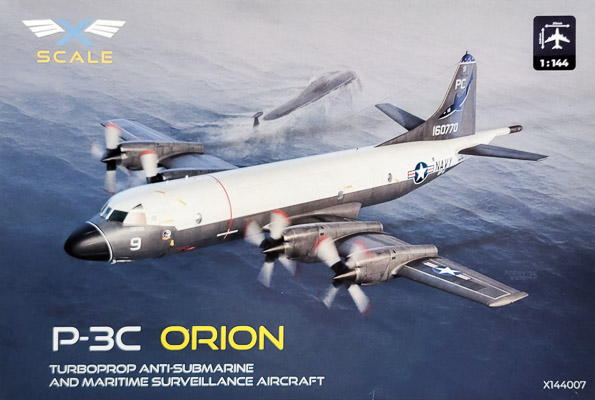
X Scale 1/144 P-3C Orion
By Chris Banyai-Riepl
Overview
The Lockheed P-3 Orion was the successor to the piston-engined P-2 Neptune, a dedicated land-based antisubmarine aircraft. The P-3 improved on the P-2 by using four turboprop engines, giving the P-3 a longer range and the ability to carry a greater weapon payload. Developed from the Lockheed Electra airliner, the Orion entered service with the US Navy in 1962 and soon became the primary land-based ASW platform for many nations in both Europe and Asia. In the Americas, Canada, Brazil, Argentina, and Chile all flew variants of the P-3, while in Europe the Netherlands, Greece, Germany, Portugal, Norway, and Spain all operated the P-3. Moving over to the Pacific & Indian Ocean region, Japan, Taiwan, South Korea, Pakistan, Iran, Australia, New Zealand, and Thailand all flew the Orion. Additionally, there were government agencies such as NOAA and NASA that flew the P-3, and civilian operators also flew the type as firebombers.
The Kit
Following on the heels of their Lockheed Electra kit, X Scale has come out with the logical iteration of that plane, the Lockheed P-3C Orion. This isn’t the first P-3 kit in this scale, as LS came out with a decent kit back in the early 1980s, but that one is definitely long in tooth. So a new-tool P-3C kit is very welcome indeed, and X Scale has done an excellent job with this kit, featuring excellent surface detailing, a detailed cockpit, a set of AGM-84 Harpoons, and a plethora of antennae to populate the fuselage. The decals provide marking options for five Orions from four countries, covering a wide range of camouflage schemes.
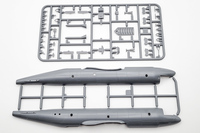
|
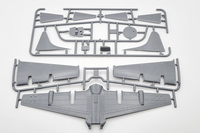
|
All P-3Cs are not created equal, though, and the type went through many different upgrades. This kit represents the latest upgrade variant, a Block III P-3C, which can be discerned from the AN/AAR-47 IR threat warning sensors on the radome and the AN/ALE chaff/flare dispensers that go on the lower nose. Those chaff/flare dispensers are separate, so you could also build an earlier Block II/II½ P-3C, and if you have one of those LS P-3 kits, you could rob the AN/AXR-13 LLLTV (low-light-level TV) pod, the AN/ALQ-78 ECM pod, and KA-74A camera parts to do an original P-3C or an Update I P-3C (just leave off the Harpoons). While the kit does represent a Block III aircraft, that still covers decades of operation, from the 1980s onwards, so there will be no shortage of marking choices.
Jumping into the actual construction, like most aircraft this kit starts with the cockpit. Having built the X Scale DC-8 and went to town on the interior, I can honestly say that most of this won’t be visible, but it’s still great to have it, just in case. There’s a rear bulkhead, a cockpit floor, two side pieces, four seats, a center console, and a two-piece instrument panel and hood. With some different colors and textures applied to all of these, enough should be seen to stand out. The completed cockpit then gets sandwiched between the fuselage halves, and you will want to pay attention to the instructions and add weight to the nose. Also getting added is the nose wheel well, and with those in, the fuselage can get glued together.
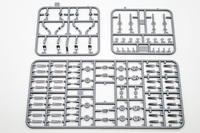
|
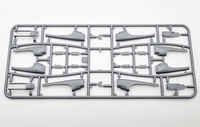
|
The next step is the wings, and this is split into upper wing halves and a one-piece lower wing. Trapped between these pieces are the back parts of the main wheel wells, which are further developed with the addition of all the nacelle pieces. The outer nacelles are built up from right and left halves and slip over the wing, while the inboard nacelles have the top and forward part split in half with an insert for the wheel well bulkhead, and the bottom aft section an additional separate piece. All four nacelles then have a separate front piece with the intake and propeller face, and separate exhaust pieces. While there might be a lot of parts here, doing it this way helps keep all the detail nice and crisp.
With the nacelles on the wing, the next step is the major airframe assembly. The wing subassembly can be added to the fuselage and mating up to that is a separate insert for the sonobuoy tubes. This hints at a possible P-3A/B down the road, as that’s one of the major visual differences between the early P-3s and the later P-3C: early ones did not have a bunch of sonobuoy tubes. Other bits and pieces that add to the major airframe are the stabilizers, split into an upper piece that features wraparound leading and trailing edges with a lower side insert, the mad boom split into right and left halves, and the vertical fin, which is set up like the stabilizers in halves, with one side having wraparound leading and trailing edges. The one-piece clear windscreen can also be added, along with all the windows on the fuselage sides.
Smaller details include the propellers, which all feature separate blades and a two-piece hub. The separate blades allow you to change the pitch of the propellers and show your model with feathered blades should you so wish. The landing gear is nicely detailed, with both the nose gear and main gear being built up from four pieces each. The main wheels are also split into right and left halves for all four of those wheels, while the nose wheels are just single pieces. Four wingtip pylons, a pair of chaff/flare dispensers on the nose, and a bunch of antennas round out the assembly, plus the four Harpoons that have two sets of separate fins.
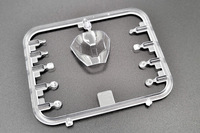
|
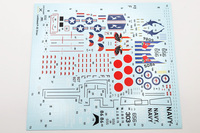
|
For marking options, this kit covers just about all the major color schemes worn by the P-3. The first option is a VP-16 Orion out of Malta in September 2010. This plane is finished in overall gray. The next option is the boxtop scheme, the special scheme worn by a VP-6 Orion for the Centennial of Naval Aviation, as seen in 2015. This scheme replicates the camouflage worn by early P-3s, consisting of engine gray with a white fuselage top. Moving to the other side of the Pacific, the next choice is an Australian P-3 from 1987, finished in the classic scheme of light gull gray and white, with colorful squadron markings on the tail consisting of a blue band with a white gull. Also in the gull gray and white scheme is the option for the Japanese Navy, a plane based out of Atsugi in 1995. This plane has colorful tail markings as well, with three diagonal blue lines and a stylized Mt Fuji in red and white over the top. The final option is from the Royal Netherlands Navy from 2001, finished in extra dark sea gray over sky. The decals include stenciling and other details, in addition the individual aircraft markings. The decals are nicely printed with excellent register and color density.
Conclusion
While the old LS kit has held up relatively well over the decades since its release, having a new-tool 1/144 P-3 Orion kit is very welcome, especially with the level of detail this kit has. Here’s hoping that the aftermarket decal companies will cater to this with a bunch of decal options and that X Scale expands on this and does an earlier P-3C as well as the P-3A & B to open up even more marking options. My thanks to X Scale for the review sample.
